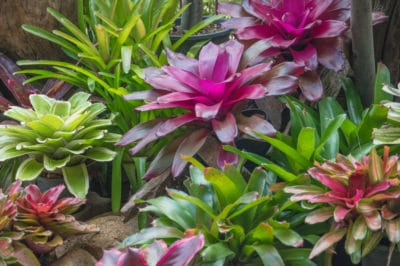Bromeliad Characteristics
Despite their diverse appearance, bromeliads have a few common characteristics. First, all are tropical or sub-tropical plants, although a few can tolerate temperatures just above freezing for a short time. Second, all have leaves arranged in a spiral fashion called a rosette. In some the leaf base overlaps and forms a water reservoir. Finally, they all have tiny scales on their leaves – called trichomes – for water absorption.
Bromeliad Habitats
Bromeliads are almost exclusively found in the New World tropics and subtropics – one species is native to West Africa. The majority come from South America. Depending on the variety, they may grow at altitudes from sea level to 14,000 feet. Some grow in hot dry deserts, while others prefer moist rainforests. Some bromeliads are also found in cooler mountain regions. Many are used as houseplants or grown outdoors in USDA Zones 9 and above.
Growth Habits
Bromeliads belong to one of three main groups. Some species may have two growth patterns. The main groups are:
- Terrestrial – these plants put down roots into the ground to get their water and nourishment.
- Saxicolous – this group attaches itself to rocks by means of stolons.
- Epiphytic – these non-parasitic plants attach themselves to trees or other structures and get water and nutrients from the air.
The Pineapple
The most well-known bromeliad is probably the pineapple (Ananas comosus). Columbus brought specimens back to Spain in 1493 after finding it in the West Indies. This lush tropical fruit quickly spread into regions where it could be cultivated, like India. The pineapple is one of the bromeliads that grows in the ground, and is the only one that produces an edible fruit.
Bromeliad Flowers
In most cases, bromeliads only flower once. Some flowers are so small or inconspicuous that they are not noticeable, but the plant’s leaves may be extremely colorful. Others are dramatic and might tower 30 feet in the air. Flowers may last a week or two or as long as a year. Blooms may be fragrant or unscented. Once the plant has flowered, it develops offsets known as pups.
Bromeliad Uses
Many bromeliads are used as houseplants, particularly those with colored or patterned leaves. Tillandsias (air plants), Guzmanias, Aechmeas and Vriesias are readily available. Some do better in sun rooms or greenhouses, others make good windowsill plants. In addition the Caroa species is cultivated for fiber. Pineapple is also the source of bromelain, which is used to tenderize meat.
